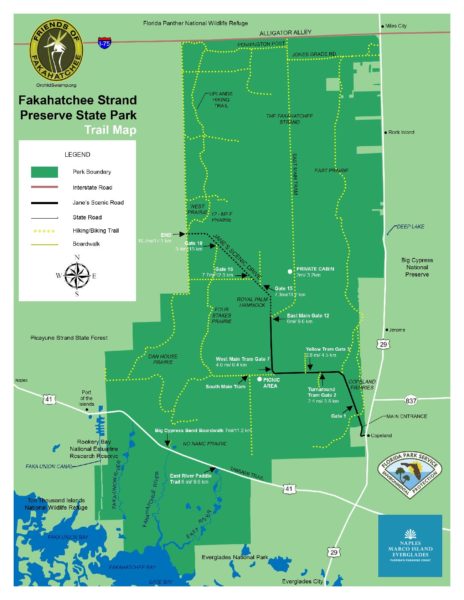Friends of Fakahatchee: Dedicated to financial and volunteer support to preserve the unique ecology and cultural heritage of Fakahatchee Strand Preserve State Park and educate the public about its importance. Banner photo by Dennis Goodman
About the Fakahatchee Strand Preserve State Park
From Exploitation to Preservation
The Fakahatchee Strand Preserve State Park is perhaps the best examples of subtropical, strand swamp in the United States. The Fakahatchee Strand is a linear swamp forest, approximately twenty miles long by five miles wide and oriented from north to south. The Strand harbors one of the largest concentrations and diversity of native orchids in North America, and supports numerous rare and endangered animal species. It is also one of the core areas of the current range of the Florida Panther.
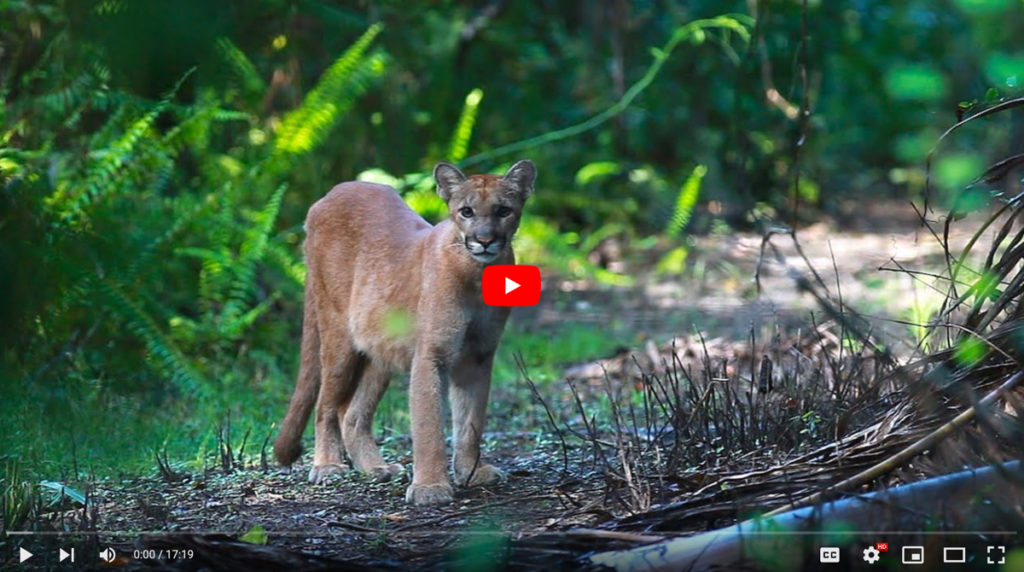
This documentary, created for the Friends by photographer Jay Staton, explores the history of the Fakahatchee and showcases the accomplishments of the Friends of Fakahatchee including the new boardwalk site. (View video on YouTube – https://youtu.be/Rz32inxYb6Q ).
The Strand’s 85,000 acres are part of the main drainage slough of the Big Cypress Swamp. The Fakahatchee Strand is linked hydrologically to the Everglades system and is particularly important to the estuarine ecosystem of the Ten Thousand Islands area.
The logging of the Strand from 1944 to 1954 resulted in the felling of thousands of cypress trees that were hundreds of years old. To remove this valuable timber, miles of tram roads were constructed in what is now the Preserve. A few of these are kept open for park maintenance and hiking, providing today’s visitors with access to this unique ecosystem.
Although there is limited access to the preserve, visitors can see some areas by driving on Janes Scenic Drive, an 11-mile-long gravel road. However, at Big Cypress Bend, on the north side of US-41 (Tamiami Trail), about 7 miles west of SR-29, visitors can walk along a 2,000-foot-long boardwalk to experience the beauty of a magnificent old growth cypress forest.
Past to Present
The story of the creation of the Fakahatchee Strand Preserve State Park is the story of Florida: unbridled resource exploitation, irresponsible development, intrigue, and champions. In the end, we win and nature wins.
The Logging Era – 1913–1948
In 1913, the Fakahatchee Strand was purchased by the Lee-Tidewater Cypress Company for $1.4 million, with the intent of logging the cypress.
Major logging did not occur, however, until 1944 as a war-time measure. Major logging operations continued until the early 1950s.
The lag time for commencing major logging operations may have been due to the real estate boom of the mid-1920s and the subsequent depression years. It has been reported that in 1922 an agent for Henry Ford obtained an option to purchase the Strand with the intention of giving it to the state as a park, but the offer did not materialize.
Preservation Attempts Fail – 1948–1964
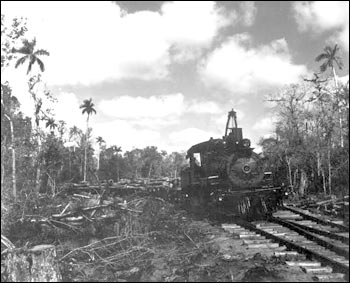
To get valuable timber to the train at Copeland, miles of tram roads were constructed.
By 1948, the southern 10 miles of the Fakahatchee Strand had been logged when Dan Beard, the superintendent of Everglades National Park, inspected the Strand and recommended it for a National Monument.
At the time, approximately one million board feet of cypress per week were being removed from the Strand. It was pointed out that the density of mammalian life found in the Strand was greater than that of the Everglades National Park, including black bear, Florida panther, mangrove fox, and a wide diversity of other wildlife. Beard also commented on the picturesque beauty of the area.
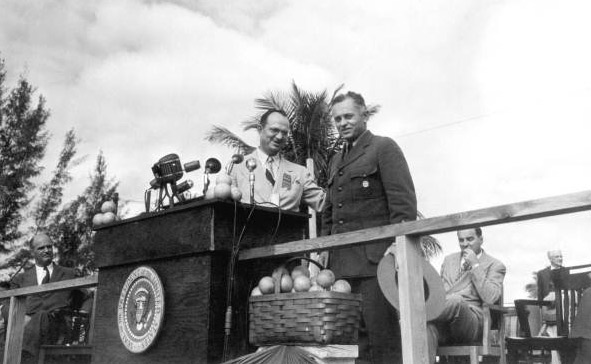
Dan Beard, first first superintendent of Everglades National Park, at dedication in 1947. He recommended that Fakahatchee Strand be included within the park’s boundaries.
While funding and authority to acquire the area did not materialize in the late 1940s, another attempt was made in 1964, under urging of Mel Finn, a Miami attorney and conservationist. However, once again the effort to preserve the Strand failed.
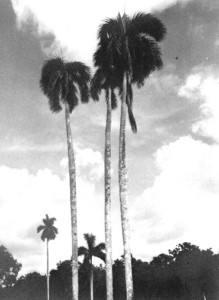
Royal palms are a hallmark of the park. Sadly, their great height and visibility are all that remains of the old growth cypress forest they once called home.
Selling Swamp Land in Florida – 1966–1972
In 1966, the Lee-Tidewater Cypress Company sold the Strand to the Gulf-American Land Company, which later became G.A.C. Properties, Inc. (GAC). GAC purchased the property with the intention of marketing the land as a part of Golden Gate Estates. Much of the property was sold in 1 1⁄4-acre lots. During this period, three sections of the Strand were donated to Collier County for a park.
Florida Legislature Sets the Stage for Conservation – 1972
In 1972, the Florida legislature passed the Land Conservation Act (Chapter 259, F.S.), which had as its purpose the conservation and protection of environmentally unique and irreplaceable lands. Later that year, Florida voters approved a bond issue of $240 million which set in motion Florida’s first major environmental land acquisition program known as the Environmentally Endangered Lands (EEL) Program. The Program was administered through the Div. of Recreation and Parks of the Dept. of Natural Resources.
Forty Years of Acquisition Begins
Negotiations with GAC began in 1972. GAC attempted to regain possession of lots it had sold and offered to sell its holdings to the State. Negotiations were temporarily halted when GAC was prosecuted for alleged dredge and fill violations at Cape Coral in Charlotte County. To resolve this litigation, GAC offered to pay for damages by trading land in the Fakahatchee Strand. Settlement of the litigation resulted in approximately 9,523 acres south of US Hwy 41 being acquired.
The first purchase of land creating Fakahatchee Strand State Park, made in June 1974, was the beginning of a continuous acquisition effort which is ongoing to this day. By 1978 approximately 44,000 acres had been acquired. As of January 1, 1999, the Preserve consisted of 69,896 acres. Of this, approximately 34,727 acres were acquired under the EEL Program. As that program came to an end, the acquisition effort was assumed by the Conservation and Recreation Lands (CARL) Program. Under the CARL Program, the project has been expanded to include lands between the older project and SR 29.
All this time, approximately 16,700 acres remain to be acquired. Since 1990, most lands have been acquired with Preservation 2000 funding. Hopefully, this noteworthy acquisition effort will continue with the use of these funds or successive funding until all reasonable efforts to complete the project have been exhausted.
©2008 Franklin Adams, Friends of Fakahatchee
Our History Recorded
In the summer of 2023 Franklin Adams gave Executive Director Francine Stevens two boxes of fragile historical documents, his documents and Mel Finn’s documents. Newspapers and magazine articles and correspondence letters dating back to 1959 capture their pursuit to save the Fakahatchee from real estate development. Jane Parks, also turned over documents she had kept since the 1960’s when she too was
involved in saving the Fakahatchee.
Over 800 documents were scanned and we will now begin to share some of the most interesting documents recording their efforts, set backs, and progress.
Document 1: August 10, 1962 – Mel Finn Inquires about Acquisitions in Big Cypress
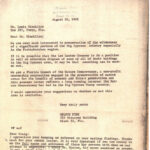
Mel Finn approaches Lee Lumber Company about the sale or “otherwise” disposal of the lands of the “Fachtahatchee” for the purpose of “preservation of the wilderness.”
Document 2:J.C Turner Lumber Company Responds to Inquiry
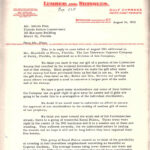
J. A. Currey, President of Turner Lumber, replies to Mel Finn that he doubts that the stockholders would want to make a “gift of some of our property,” and that a “group of Royal Palms caused us to think of creating” something like the “Cypress Gardens” attraction.
A History of Conservation Champions
1922
Henry Ford, winter resident of Fort Myers, offers to buy the Strand and give it to the State of Florida. The State refuses, citing need to keep the Fakahatchee on the tax roles and plentitude of ‘swamp land.’
1932
Garden clubs launch an unsuccessful movement for protection in response to the removal and sale of Royal Palms.
1944
The Lee Tidewater Cypress Company establishes headquarters at Copeland; the Federal government wants cypress for war-time construction of wooden boats.
1947
Public response to old-growth logging emerges in Media as Everglades National Park is dedicated by Harry S. Truman. The Fakahatchee just misses being included within its boundaries.
1948
National Parks Association brings attention to destruction of Fakahatchee. Dan Beard, first superintendent of Everglades National Park, is sent to investigate, and recommends the Strand be included in the park. This recommendation was tabled.
1957
As the Fakahatchee is totally logged out, National Audubon Society manages to snatch a bird rookery swamp from destruction, now known as Corkscrew Swamp Sanctuary.
1962
Orchid lover Melvin “Mel” Finn, a Miami attorney, founds the Florida Nature Conservancy. He attempts to save the Fakahatchee Strand from land speculators, but Gulf American Land Corporation buys the land at $100 per acre (on paper) from Lee Tidewater Cypress. Lots are sold in “Remuda Ranch Grants” for $2500 per acre. The central building of the Port of the Islands was part of the development plan.
1966
Congressman Paul Rogers introduces bill to declare the Fakahatchee a National Wilderness Monument, but Biscayne Park was selected instead. Gulf American Land Corporation begins to dig drainage canals, and is cited for illegal dredge and fill in Cape Coral.
1970
Mel Finn brings State dignitaries and agency heads to tour the Strand, convincing all it was worthy of protection.
1971
Mel Finn dies of complications of heart surgery.
1972
State of Florida agrees to settle litigation with Gulf America Land Corporation by accepting holdings in the Fakahatchee south of US 41. The state also passes the Land Conservation Act, creating the Environmentally Endangered Lands Program, providing funds for acquisition.
1974
The first purchase of Fakahatchee land for creation of the park was made in June. The acquisition effort continues to date.
1999
Nathaniel Reed, Joel Kuperberg, and others arranged for a memorial to Mel Finn. On April 24, 1999, the monument that stands in front of the Park office in Copeland was dedicated to memorialize Mel Finn’s many years of devotion to his beloved “Fahkahatchee,” as he spelled it.
The Mel Finn Award
Mel Finn has been called “the Father of the Fakahatchee” in recognition of his personal crusade to save the Fakahatchee Strand, and his efforts to convince the State to preserve this special place through funds to acquire it.
Mel Finn (1916-1971) was a Miami lawyer and conservationist. He knew that despite the environmental damage caused by the logging of the 1940s and 1950s, the Fakahatchee was a unique place worth saving. He worked hard to raise public awareness of the fact that the Fakahatchee was home to many rare and endangered species of plants and animals. He personally spoke to politicians and environmental groups about the need to save the Fakahatchee. He led a delegation of political dignitaries into the swamp to show them the beauty of the place firsthand. Although his dream was not realized during his lifetime, his determination and tenacity ultimately led to the Fakahatchee becoming a state preserve.
On April 24, 1998, the Friends of the Fakahatchee dedicated a plaque to Mel Finn. It is prominently located on a large piece of limestone in front of the park office.
The Friends also created a special award in his honor, called “The Mel Finn Award.” This award is given to individuals who have given their time to benefit the Fakahatachee and who, as it states on the award, “reflect the spirit of the founding father of the FSSP.”

At the Friends 25th Anniversary celebration, Dr. John Kaiser received the 2023 Mel Finn award for his outstanding dedication to raise funds by guiding the Friends tour program. In a span of almost 10 years John’s morning tram tour and famous Moonlit tram tour generated $42,800 to support the park, clearly surpassing everyone’s expectations!
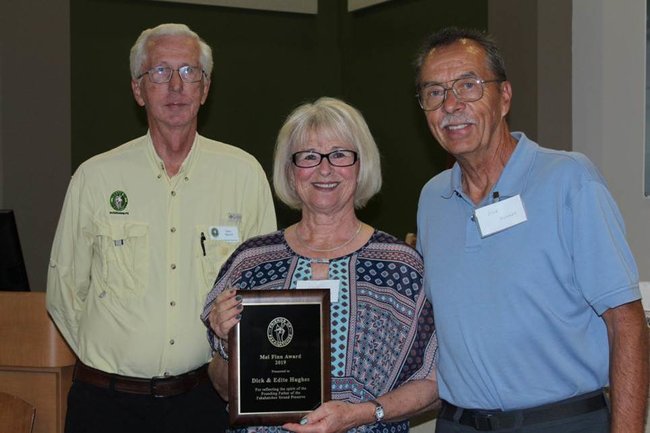
FOF President Glen Stacell presented the 2019 Mel Finn award to Dick and Edite Hughes, for their 15 years of dedication to keep the Boardwalk in good repair. The Park is the beneficiary of their skills and the generosity of their time through the years. Thank you and congratulations, Edite and Dick!
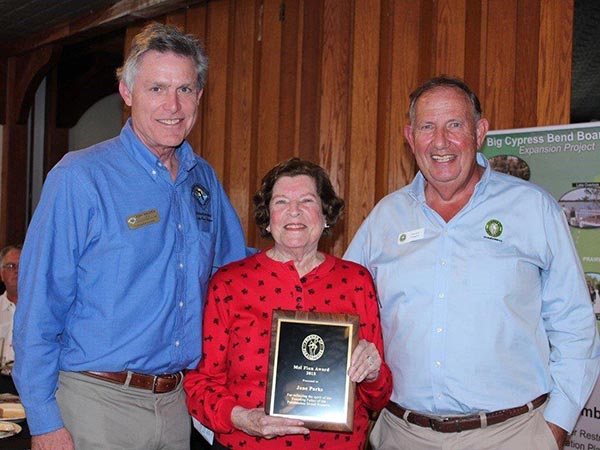
Mrs. Jane Parks received the 2018 Mel Finn Award, in recognition of her outstanding efforts to save the Fakahatchee from real estate development. “In the early 1960s, years before our organization existed,” said Patrick Higgins, “she was working tirelessly to preserve the Fakahatchee as Chairman of the Junior Women’s Club. She organized an aggressive letter writing campaign and presented a petition to the state in support of preservation, on a roll of paper 175 feet long.” Director of Florida State Parks Eric Draper also praised Mrs. Parks. Francine Stevens added, “Jane does not brag, so we have to brag for her.” Well done, Jane!
2023 Dr. John Kaiser
2019 Edite and Dick Hughes
2018 Jane Parks
2017 Dino Barone
2016 Patrick Higgins
2015 Howard Lubel
2014 Bill Mesce
2013 Glen Stacell
2012 Caryl Tilden
2011 Tom Maish
2010 Marya Repko
2009 Nelson Tilden
2008 Allen Caldwell
2007 John Elting
2005 Franklin Adams
Barbara Lewinski
Elsa Caldwell
Dennis Marlin
Roger Dykstra
Don Harmon

